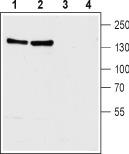Slc8a1 Rabbit Polyclonal Antibody
Frequently bought together (1)
beta Actin Mouse Monoclonal Antibody, Clone OTI1, Loading Control
USD 200.00
Other products for "Slc8a1"
Specifications
| Product Data | |
| Applications | IHC, WB |
| Recommended Dilution | WB: 1:200-1:2000; IHC: 1:100-1:3000 |
| Reactivities | Mouse, Rat |
| Host | Rabbit |
| Clonality | Polyclonal |
| Immunogen | Peptide (C)EVDERDQDDEEAR, corresponding to amino acid residues 308-320 of rat NCX-1 . 3rd intracellular loop. |
| Formulation | Lyophilized. Concentration before lyophilization ~0.8mg/ml (lot dependent, please refer to CoA along with shipment for actual concentration). Buffer before lyophilization: Phosphate buffered saline (PBS), pH 7.4, 1% BSA, 0.05% NaN3. |
| Reconstitution Method | Add 50 ul double distilled water (DDW) to the lyophilized powder. |
| Purification | Affinity purified on immobilized antigen. |
| Conjugation | Unconjugated |
| Storage | Store at -20°C as received. |
| Stability | Stable for 12 months from date of receipt. |
| Gene Name | solute carrier family 8 member A1 |
| Database Link | |
| Background | Ca2+Â has proven to be a universal signaling molecule in excitable and non-excitable cells. However, being that its intracellular concentration is 1000 time lower than the extracellular milieu, it is important for the cell to keep this ratio for proper function. NCX, a Na+/Ca2+Â exchanger is responsible for most of the efflux of Ca2+Â out from the cell.The NCX transporter is a member of the SLC8 family of solute carriers which in turn belong to the CaCA superfamily.NCX-1 is one of three Na+/Ca2+ exchangers (NCX-1, NCX-2, NCX-3) leading to one Ca2+ movement across the plasma membrane in exchange of three Na+ influx. However, the transporter can reverse the direction of the transport if the concentrations of Na+ and Ca2+ change.The transporter has nine transmembrane domains and intracellular N- and C-terminals. Between tansmembrane domains 5 and 6, the presence of an extra-long intracellular loop, termed the f loop is responsible for regulating the activity of NCX-1 via several different mechanisms like ion binding, phosphorylation, etc. The f loop also has sites which undergo alternative splicing.Of the three NCX-1 expressed in mammalian cells, NCX-1 is the most widely expressed. Its expression is detected in the heart, brain, and kidney. NCX-1 undergoes alternative splicing in a tissue dependent manner. The first splice region does not change the overall structure of the protein but rather enables the expression of the gene specific to the tissues which require the expression of the gene. The second splicing site leads to a number of proteins varying in length. NCX-2 expression is much more limited; it is expressed only in neurons. NCX-3 is expressed in skeletal muscle and in some regions of the brain and undergoes alternative splicing in a similar fashion to that of NCX-1.Due to its central role in modulating Ca2+ levels in the cell, NCX-1 has become a pharmaceutical target in the development of drugs for various heart diseases and neurological disorders. |
| Synonyms | CNC; DKFZp779F0871; FLJ37694; FLJ43417; MGC119581; NCX1; OTTHUMP00000128378; OTTHUMP00000201569; OTTHUMP00000201570; OTTHUMP00000201587; OTTHUMP00000201589 |
| Reference Data | |
Documents
| Product Manuals |
| FAQs |
| SDS |
{0} Product Review(s)
0 Product Review(s)
Submit review
Be the first one to submit a review
Product Citations
*Delivery time may vary from web posted schedule. Occasional delays may occur due to unforeseen
complexities in the preparation of your product. International customers may expect an additional 1-2 weeks
in shipping.






























































































































































































































































 Germany
Germany
 Japan
Japan
 United Kingdom
United Kingdom
 China
China





